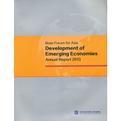Boao Forum for Asia Development of Emerging Economies Annual Report 2013-博鳌亚洲论坛新兴经济体发展2013年度报告-英文版
出版时间:2013-3 出版社:对外经贸大学出版社
书籍目录
Notes and Acknowledgements Preface Chapter 1 Overview: Reviewing and Anticipating the Economic Situation of the Ell 1.1 Economic Growth with a Lower Speed in 2012 1.2 A Modest Economic Recovery in 2013 Chapter 2 Basic Social Conditions of the Ell 2.1 Natural Resources 2.2 PopulationResources 2.3 SociaICapital 2.4 Infrastructure Chapter 3 Basic Economic Conditions of the Ell 3.1 Continuing Expansion ofthe Economic Scale, Uneven Level of Economic Development 3.2 Better Fiscal Balance Ability, Lower Public Debt Burden 3.3 Easing Inflationary Pressures, Differential Performance in the Real Exchange Rate 3.4 Relieved Pressure of Unemployment and Large Potential Room for Structural Adjustment 3.5 More Balanced Current Accounts and Slower InternationaITrade Growth 3.6 Low Interest Rates and Rebounded Stock Markets Chapter 4 Economic Performances and International Rankings of the Ell 4.1 Slow but Strong Economic Recovery 4.2 Fast but Unstable Growth in Labor Productivity and TFP 4.3 Lower Speed in Export Expansion 4.4 Rising Global Share of FDI with Accelerated Outward FDI 4.5 Steady Growth in International Reserves 4.6 Changes in Major International Rankings of the El1 4.7 Changes in Corporate Strength ofthe Ell Chapter 5 Economic Cooperation among the Ell Economies 5.1 LowerTrade Growth but CloserTrade Relations 5.2 Decreased Mutual FDI but Outstanding China Performance 5.3 Financial Cooperation among the Ell Economies Chapter 6 Economic Cooperation between the E11 and Developed Economies 5.1 Trade Links between the Ell and Developed Economies 5.2 Direct Investment between the Ell and Developed Economies Chapter 7 Country Report ofthe Ell Economies 7.1 Argentina 7.2 Brazil 7.3 China 7.4 India 7.5 Indonesia 7.6 Korea 7.7 Mexico 7.8 Russia 7.9 Saudi Arabia 7.10 South Africa 7.11 Turkey References
章节摘录
版权页: 插图: In 2011, Korea's market exchange-based GDP reached US$1.12 trillion, the 15th largest globally, up by US$101.4 billion, or a real 3.6%, year-on-year. Its PPP-based GDP reached 1.55 trillion international dollars, accounting for 1.97 percent of the total global output. In the first three quarters of 20] 2, Korea's economic growth remained low and even though it stabilized and recovered mildly in the fourth quarter, the whole-year growth was expected to reach only 2.3%. In reality, since the second quarter of 2011, the country's real year-on-year GDP growth had been going down continually and repeatedly beaten market expectations. Since it started to go down from 3.6%, there had been still no signs of stabilization. In the third quarter of 2012, its growth rate slumped from 2.3% achieved in the previous quarter to ].6%, which was the lowest since the third quarter of 2009. However, the trend of economic downturn could be curbed and reversed in the fourth quarter of the year. Korea's export and import failed to have a sound performance in the first three quarters of 2012. In the third quarter, export and import dropped year-on-year for the third consecutive months, when import value dropped by 7% on average while export value fell by 4.6% on average.The downturn was reversed in the fourth quarter. In October and November, its import increased by 1.6% and 0.9% month-on-month, respectively, while its export increased by 1% and 3.8% month-on-month,respectively. The strong export growth in November was mainly attributable to regional trade. Its export to Asian regions increased by 11.6% year-on-year in that month, when its export to Africa increased by 9.3%. But due to the unfavourable international environment, Korea's export to other regions continued to contract. Regarding domestic demand,there had been some improvement in private consumption. Sales of top-notch department stores still decreased in October, but the 0.4% decline was already narrowed than the 0.8% drop in the previous month. In November, the sales grew strongly by 10.2%. Sales of discount stores fell by 2.1% in November, which was also lower than the 6.6% drop in the previous month. However, given the official prudent macroeconomic policy, the fixed-asset investment had been very weak. Consumption-backed domestic demand would become the main driving force for Korea's future economic growth. In 2012, Korea could largely shake off the threat of deflation. Prices would stabilize at low levels. In the third quarter, its CPI growth rate continued to be on the falling track, a trend established since early 2012, and dropped to 1.6% from 2.4% in the second quarter. Since September, however, its CPI had been higher than in previous months for three consecutive months, rising by 2% (September), 2.1% (October) and 1.6% (November), which means the risk of deflation can be largely ruled out. Meanwhile,its core inflation (excluding the weight of agricultural product and oil prices) rose by 1.4%, 1.5% and 1.3% in the three months, respectively. The change was very slight compared with that in July and August,when it was 1.2% and 1.3%, respectively, which meant if there were no external shocks, inflation might not break the 2% line set by the Korean central bank. In 20] 3, inflation may rise higher thanks to expected economic recovery.
编辑推荐
《博鳌亚洲论坛新兴经济体发展2013年度报告(英文)》由中国社会科学院世界经济与政治研究所所长张宇燕教授主持编写,并负责整个报告的框架设计。
图书封面
评论、评分、阅读与下载
用户评论 (总计0条)
推荐图书
- 大学生创业基础
- 创意黑板报设计编排集锦
- 甘南藏族自治州民族特色化建筑标准图集
- 财务会计实务
- 法学概论
- 工业工程导论
- 古文诗词中的地球与环境事件
- 反思参与式发展
- 工业品牌营销20问
- 产业园
- 城市综合体
- 大地的皱折-NO.24-中文版
- 风景写生
- 复杂自适应系统联合仿真建模理论及应用
- 高级篇-吃子.精讲与精炼
- 大学金砖英语视听说教程-2
- 大学金砖英语视听说教程-1
- 博鳌亚洲论坛新兴经济体发展2013年度报告
- 博鳌亚洲论坛亚洲竞争力2013年度报告
- 博鳌亚洲论坛亚洲经济一体化进程2013年度报告
- 电力通信光缆施工实训教程
- 电力安全事故分析原理与案例分析
- 电力调度运行专业知识习题集
- 成就优秀女孩的8个好习惯
- 读懂鬼谷子大智慧
